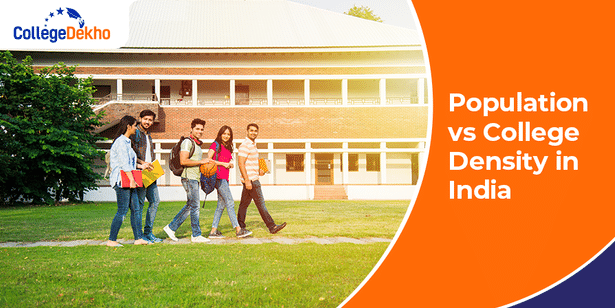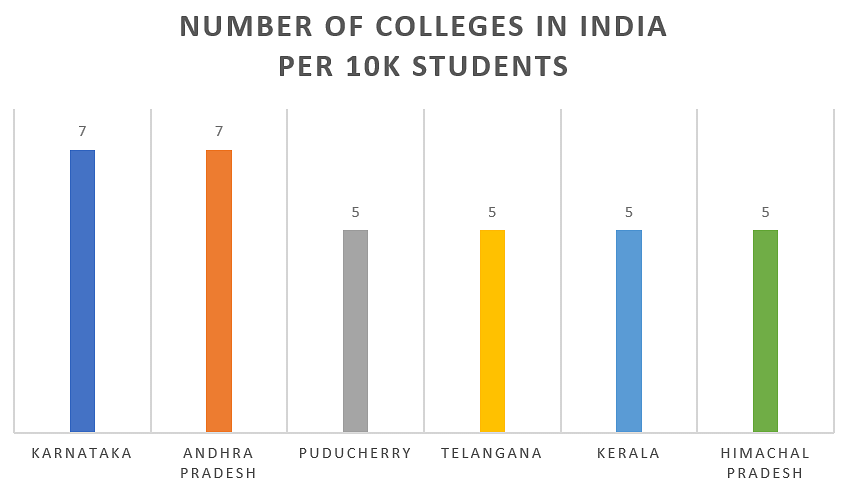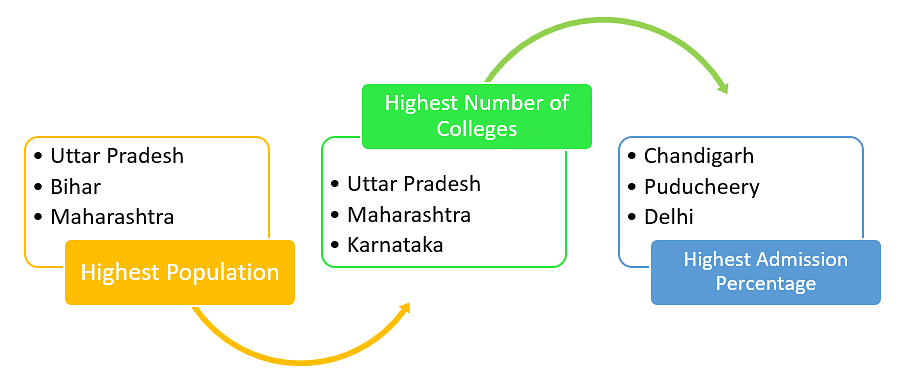
Uptil about 10 years ago, the only way one could secure a solid job was to get quality education from a reputable institute. And many of us would have crossed the seven seas to pursue quality higher education. This is not the case today: with NEP 2020, the government set a GER target of 35% by 2035, from the current GER % of 28.3%. This means, there has to be a well distributed network of colleges across India's geography to achieve this target.
The Higher Education Analytics & Regional Trends (HEART) report by CollegeDekho will give you an insight into the college vs student distribution density, along with the migration trends for the last 3 years. It will also tell you the top courses preferred by students to study at the undergraduate, post graduate & Ph.D level.
India has a population of 175 million within the 18 to 24 age group, indicating that the country has one college for every 3240 higher education aspirants. This ratio in the USA is much higher at once college per 7500+ students. India’s challenge with college infrastructure is not over the number of colleges but its distribution. This report delves into the wider details of the challenges and the changing education landscape of the country.
Population vs College Density in India
The All India Survey for Higher Education (AISHE) registers over 54,000 colleges. Out of these, over 35,000 or approximately 75% of colleges are in nine states alone. It creates an uneven population vs college density. It leads to intra-state migration or students changing their higher education field to avoid the same, for reasons financial or otherwise.
The Trends Report 2024 by CollegeDekho details that Uttar Pradesh has the highest number of colleges in India at 8375, followed by Maharashtra at 4692, and Karnataka at 4430. But if population vs college density is considered, Karnataka has the highest number of colleges available per student. On the other hand, Uttar Pradesh does not rank in the top 10 states for college availability. Although Karnataka has fewer colleges compared to Maharashtra, its 18-24 population is also significantly lower.
“Karnataka has 7 colleges per 10,000 students,” CollegeDekho’s HEART report analyses, “while Maharashtra has 4 colleges for the same number of students. The number for Uttar Pradesh is even lower.” Delhi, the capital of India, has one of the lowest number of colleges per 10k students, alongside Jharkhand and Bihar.
The following infographic shows the top 5 states with their population vs college density:

Population vs Admissions Density in India
As seen so far, the trends have changed from the total state-wise number of colleges to the population vs number of colleges. Again when the state-wise percentage of admissions is observed, CollegeDekho Trends Report 2024 suggests that the highest population vs admission percentage is in Chandigarh. About 64.8% of the 18-23 age group population secure admission in Chandigarh, the highest in the country.
The state population vs admission density is low for the states with the highest number of colleges in India. It is due to intra-state migration. For example, Uttar Pradesh has a low number of colleges per 10k students. Hence, the UP population may prefer to migrate to Delhi or Chandigarh for better opportunities. Another example is Karnataka, which has the highest number of colleges per 10k population but it ranks at #12 for population vs admission density.
18-23 Population-wise, the top 5 states are Uttar Pradesh, Bihar, Maharashtra, West Bengal, and Madhya Pradesh.
Enrolment-wise, the top 5 states/UTs are Chandigarh, Puducherry, Delhi, Tamil Nadu, and Himachal Pradesh.
The population vs number of colleges vs admissions density for the top 3 states/UTs in the country is shown in the infographic below:

CollegeDekho HEART Report 2024 elaborates on the population vs college infrastructure in much greater detail. It also talks about the top destination states, streams, degrees, and more that will provide insights to you as a student, parent, or teacher. It just doesn’t explore the current state of Higher Education in India, but it analyses the same over the trends of the past three years.
Are you feeling lost and unsure about what career path to take after completing 12th standard?
Say goodbye to confusion and hello to a bright future!

Was this article helpful?




















Similar Articles
Top 10 South Campus Colleges in Delhi University (DU): Courses Offered & Cutoff Trends
TG TET 2026: Exam Date (Out), Application Form, Hall Ticket, Syllabus
KARTET Hall Ticket 2025; Release Date, Steps to Download, Details Required, OMR Instructions
KARTET Paper 1 Syllabus 2025; Subject-wise breakdown with PDF
KARTET Paper 2 Syllabus 2025; Subject-wise syllabus with PDF
KSET Result 2025 Date and Time